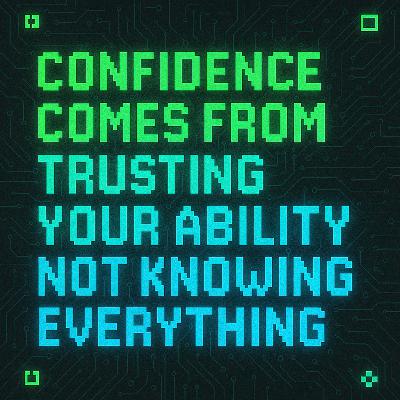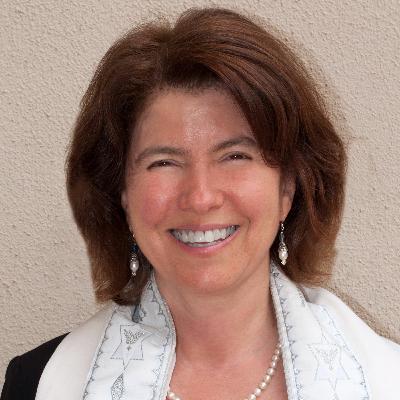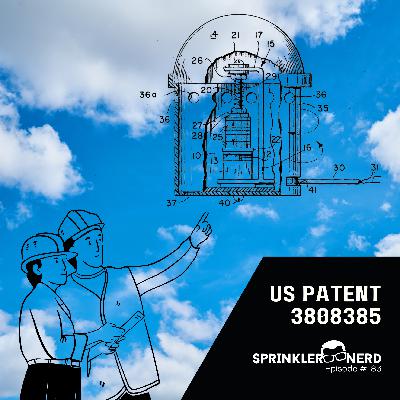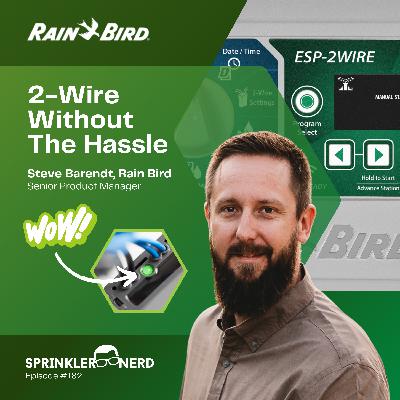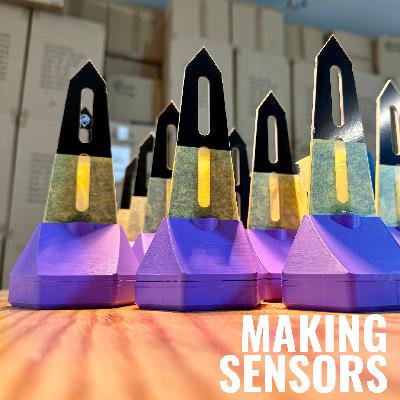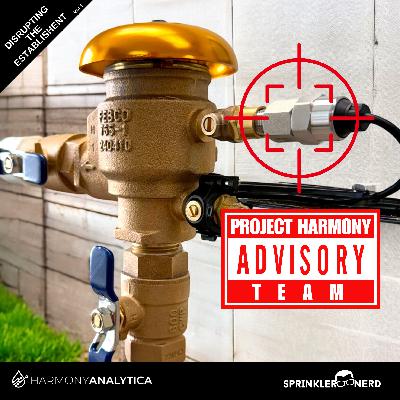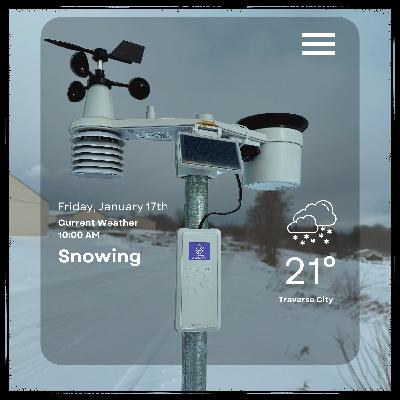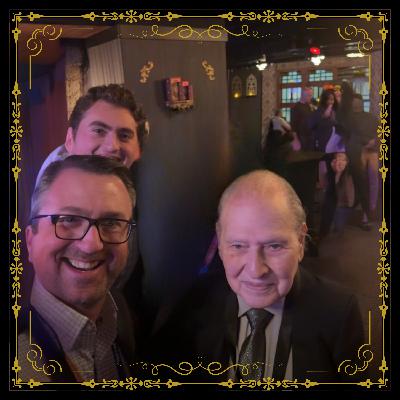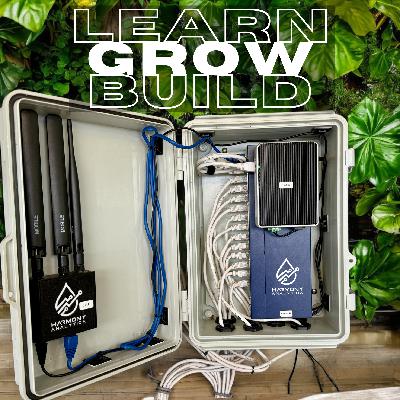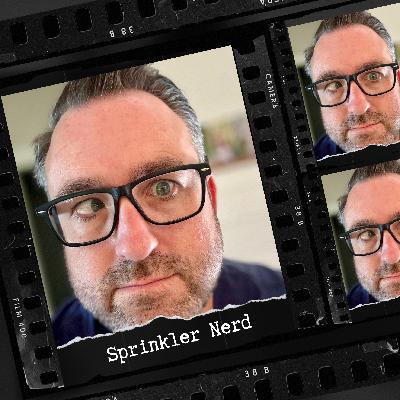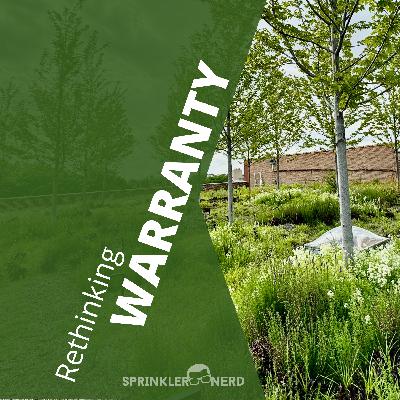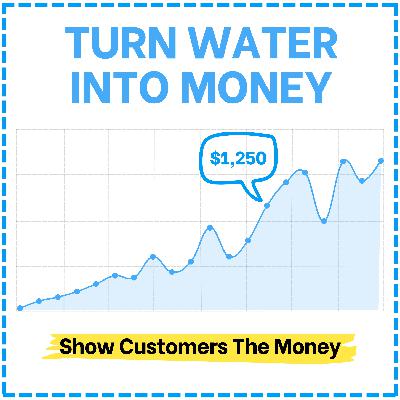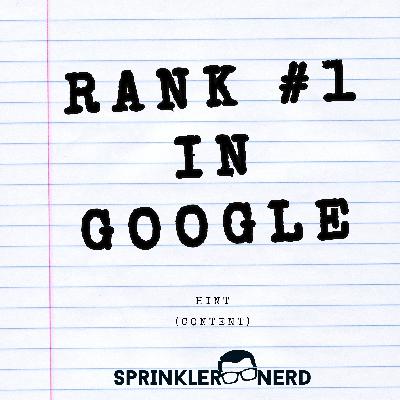Discover The Sprinkler Nerd Show
The Sprinkler Nerd Show

The Sprinkler Nerd Show
Author: Andy Humphrey
Subscribed: 18Played: 829Subscribe
Share
Copyright © 2022, Sprinkler Nerd
Description
If you are a Landscape Entrepreneur this show is for you. Andy, a former contestant on the ABC hit television series Shark Tank, irrigation technology expert, and multimillion-dollar eCommerce entrepreneur brings his curiosity & creativity to tease out the secrets of successful landscape influencers and business owners.
Discover how to get a leg up on the competition, be the smartest person at the design table, and advance your career in the irrigation and landscape industry at any level.
All stones will be unturned as Andy digs into the nerdy details of business, technology, and personal growth here on the Sprinkler Nerd show.
To join the community of Sprinkler Nerds transforming the Green Industry visit www.SprinklerNerd.com.
Discover how to get a leg up on the competition, be the smartest person at the design table, and advance your career in the irrigation and landscape industry at any level.
All stones will be unturned as Andy digs into the nerdy details of business, technology, and personal growth here on the Sprinkler Nerd show.
To join the community of Sprinkler Nerds transforming the Green Industry visit www.SprinklerNerd.com.
186 Episodes
Reverse
TXT Andy and say what's up? 208 908 3229 -- Hey friends, welcome back to The Sprinkler Nerd Show. Today, I want to take you down a slightly different path. This one's not about technology. Not about sensors. Not even about irrigation. It's about something more fundamental… something that shapes how we lead, how we teach, and how we grow. It's about the power of not knowing. Have you ever noticed what happens when someone asks you a question? What do you do? You probably give them an answer. That's what we've been trained to do. We associate knowledge with value. We think: if I have the answer, I'm helpful. I'm smart. I'm a good leader. But I want to challenge that today. What if giving the answer actually ends the conversation too soon? See, when we hand someone an answer, we're closing a door. We're wrapping it up. Putting a bow on it. Done. Solved. Move on. But growth doesn't happen in the answers. Growth happens in the thinking. In the wondering. In the exploration of possibilities. So what if, instead of handing out answers like candy, we responded with questions? Imagine this: Someone asks you, "What should I do about this issue in the field?" And instead of launching into your best advice, you say: "What options have you considered?" "What's the outcome you're aiming for?" "What do you think will happen if you try that?" Now, suddenly, you're not just giving a solution—you're creating space for discovery. You're not the answer key. You're the guide. That's leadership. That's coaching. That's power. Because when you help someone think—not just tell them what to think—you unlock something in them. You give them a skill they can use forever, not just an answer they'll forget tomorrow. And here's the twist: Not knowing isn't weakness. It's wisdom. It's humility. It's the birthplace of insight. So next time someone comes to you looking for an answer, try holding back. Ask a question instead. Keep the door open. Let the conversation breathe. Because the power of not knowing... might just be the greatest tool you have. Thanks for listening, and I'll catch you next time. Intro audio source: America, "You Can Do Magic"
Reference Link: https://player.captivate.fm/episode/ec981d8c-cd1d-4c13-961a-76cf9cf32ecb
For immediate release—breaking news, kind of. In this solo episode of The Sprinkler Nerd Show, Andy dives into what seems like a revolutionary product: a mechanical rain sensor that requires no batteries, no Wi-Fi, no firmware updates—just pure, functional design. It shuts off irrigation during rainfall and turns it back on when conditions dry out, all thanks to hygroscopic discs that expand and contract to trigger a simple switch. This device sounds like the newest drop in water-saving technology—until Andy reveals the twist: it's not new at all. In fact, it's based on US Patent 3,808,385, filed in 1972 and granted in 1974. That's over 50 years ago. And the core concept of the mechanical rain sensor hasn't changed since. Andy breaks down how the device works, why it's still effective today, and what it says about the pace of innovation in the irrigation industry. He challenges contractors and tech developers alike to ask the big question: why are we still using 1970s technology in 2025? Could we create a smarter, data-driven rain sensor that actually logs rainfall events, provides historical context, and informs better irrigation decisions? If so—why hasn't anyone built it yet? Key Highlights: Breakdown of how the moisture-responsive switch actuator works Benefits for contractors: simplicity, reliability, zero maintenance Installation and adjustment tips Why the current state of rain sensors is a wake-up call A challenge to the industry: let's rethink how we track rain and respond to it Andy closes the episode with a call to action for all Sprinkler Nerds: always ask why. Why things work the way they do, why they've stayed the same—and how we can make them better.
YouTube Short: https://youtube.com/shorts/flpTuNN7vqY Summary In this episode of the Sprinkler Nerd Show, host Andy Humphrey sits down with Steve Barendt from Rain Bird to explore the company's new ESP 2-Wire Controller—a product that's making 2-wire irrigation systems significantly more approachable for contractors who may have previously avoided them due to complexity. The Origin of the Conversation Andy first encountered Steve at the IA Show, where Steve delivered an impromptu 2-minute elevator pitch on the new controller. That pitch sparked Andy's interest in Rain Bird's new approach to two-wire systems, leading to this deeper dive discussion. Steve's Background Steve brings a decade of experience at Rain Bird, including seven years on the sales team working directly with contractors in the Austin, Texas area. His background in the field informs his work as a product manager, enabling him to better understand real-world customer needs and challenges. Why "Approachable" Matters Historically, two-wire systems have been considered complex, especially around wiring specifications, connector types, and troubleshooting. Rain Bird's ESP Two-Wire Controller aims to lower the barrier to entry, making it easier for contractors—even those new to two-wire installations—to adopt the technology. The term "approachable two-wire" is intentional. Steve explains that Rain Bird designed this controller to work with standard irrigation wire and connectors, rather than requiring specialized components. As long as the wire is direct burial irrigation wire (down to 18 gauge) and connectors are rated for 600 volts, users can leverage what's already on their trucks—reducing the learning curve and installation costs. A Big Shift: De-Energized Two-Wire Path A key innovation is that the two-wire path is not constantly energized, as it is in traditional two-wire systems. Instead, it's only powered when actively running a station or performing diagnostics. This reduces heat at the connectors and decreases corrosion risks, allowing the use of standard connectors and simplifying troubleshooting. Positioning: Who's It For? The ESP Two-Wire Controller isn't designed to replace all two-wire systems. Instead, it's aimed at light commercial and large residential projects with about 12 to 30 stations—an area where contractors often debate between traditional wiring and larger two-wire systems. Key highlights: 50-station capacity (though ideal use is around 12–30 stations) Cost break-even point starts around 12 stations, lower than the 30+ typical for traditional two-wire setups Two solenoids can operate simultaneously Compatible with a standard flow sensor (hardwired) By offering a lower break-even point and simpler installation, this controller fills a gap between traditional modular controllers like the ESP ME3 and higher-end commercial platforms like LX IVM. Troubleshooting Tools and Diagnostics Rain Bird has invested heavily in diagnostics features that make this controller easier to troubleshoot: LED Feedback on Decoders: Each decoder includes red, green, and blue LEDs that indicate operational status, short circuits, and open circuits. Short Finding Mode: Allows energizing the path for diagnostics with a clamp meter. Power-Measure Mode: Helps track power issues in the field. These features empower contractors to isolate and resolve issues faster without needing advanced tools or specialized knowledge. Auto-Addressing Decoders Perhaps the most contractor-friendly feature is the auto-address functionality. Rain Bird decoders come in numbered order, and if installed sequentially, the controller will auto-scan and assign decoder addresses to stations with no manual input. This drastically reduces setup time and minimizes human error. While other systems may require manual address entry or use specialized software, Rain Bird's solution is faster and simpler—especially when paired with the mobile app. No Field Grounding Required Another simplification: unlike other two-wire systems, no field grounding is required for this controller. Though contractors can choose to ground the system if they wish, it's not necessary for functionality or warranty compliance. Connectivity and Software Integration The controller is WiFi-enabled via Rain Bird's LNK2 module. It currently connects to Rain Bird's legacy mobile app, but a transition to Rain Bird's 2.0 app and IQ 4 web platform is planned for 2025, which will bring expanded access and remote management options. Simplified SKUs and Installation Rain Bird is offering this platform with just two SKUs: the controller and a single-station decoder. That's a major advantage for distributors and contractors, who won't need to manage complex inventories of sensor decoders, grounding kits, or multi-station decoders. Behind the Scenes: Product Development Steve shared insights into the 2–3 year development timeline, which included field testing, focus groups, and engineering across multiple departments. The goal: simplify, streamline, and make two-wire technology accessible to more contractors. Multiple patents were filed as part of the innovation process, particularly around the auto-addressing and system architecture. Final Thoughts This controller isn't for every project—but that's the point. Steve emphasized the importance of positioning the right tool for the right job. When used in the right context—light commercial sites, fast food chains, hotels, and medium-size properties—Rain Bird's ESP Two-Wire Controller can offer a compelling mix of ease-of-use, cost savings, and performance. Contractors interested in learning more are encouraged to reach out to their local Rain Bird representatives via their distributor or visit the Rain Bird website for product videos and specs. Key Takeaways Designed for simplicity and approachability Compatible with standard wire and connectors De-energized two-wire path reduces risk and simplifies install Auto-addressing decoders streamline setup Troubleshooting tools built-in (LEDs, short find mode, power measure) Ideal for 12–30 zone projects Connects via WiFi and will be fully app- and web-integrated in 2025 No field grounding required Just two SKUs for the system
Andy introducing wireless sensor technology to Ohio and riffs about the "RHYTHM" of the landscape.
In this episode, Andy shares his process for manufacturing LoRaWAN wireless soil moisture sensors.
Join the Project Harmony Launch List: HarmonyAnalytica.com/future What does the future hold for your landscape business? Well, if you ask nine experts, you'll get 10 different answers. Some say we're heading for a lush, thriving growing season; others predict drought conditions. Some insist we'll get just enough rain this year—and someone else insists it's never enough. Let's be honest, nobody really knows... But now...there is one surefire way to future-proof your business and how you manage high asset value crops: Harmony Analytica. Harmony is the FIRST sensor analytics platform made for plant-focused professionals. It is currently used by leading institutions, managers, and contractors from Agricultural, to HOA, to Green Infrastructure everywhere.. But what does Harmony Analytica actually do? It brings all of your water consumption data, irrigation schedules, localized rainfall, soil moisture levels, environmental data, and plant health metrics together into one. single. platform. That means you have a single source of truth to manage your landscape assets. No more cobbling together spreadsheets or running multiple apps, or exporting for water use, from multiple software platforms—only to end up with a "dashboard" that's outdated the moment you finish assembling it. Do you juggle endless logins for systems like Rain Bird, Toro, Hunter, Baseline, WeatherTrack, RainMaster, Calsense, Weathermatic, Smart Rain…the list is fucking long, yeah? With Harmony Analytica you can affordably add sensors for one centralized command center, saving you time, simplifying your workflow, and giving you unparalleled insight into every aspect of your irrigation strategy -without spending thousands of dollars changing our controllers. Harmony Analytica knows exactly what you need: Real-Time Insights – to track water consumption, water pressure, soil moisture, local rainfall, evapotranspiration, and more. Accurate Planning – so you can schedule irrigation and manage your resources based on data, not guesswork. Visibility & Control – to make quick, informed decisions about your landscapes in one user-friendly dashboard. Think of this as the instrument panel of your horticultural fighter jet. You want all that data to be spot on and easily accessible—so your maintenance strategy is efficient, your plants are thriving, and your business is operating sustainably. Start with one sensor, grow with many. Harmony's modular platform ensures that no matter how small your business is today, or how large your landscape operations become, Harmony Analytica is designed to scale seamlessly right alongside you. There is no minimum to get started. In short: you need Harmony Analytica. It's an amazing opportunity to revolutionize how you manage landscapes. And speaking of opportunity, do yourself a favor: Apply Now, to join the Harmony Analytica Advisory Team, where you can become a part of the development team and help shape the future of the company. In this top-secret, private group, we will break down how to leverage cutting-edge tech to keep your landscapes greener—and your bottom line stronger. Signup today: Harmony Analytica.com/future, harmonayanalytica.com/future, harmonyanalytica.com/future.
In this episode of The Sprinkler Nerd Show, host Andy Humphrey starts off with an unapologetically bold greeting to illustrate the power of authenticity and grab listeners' attention. He gives a personal shout-out to friends, mentors, and colleagues he connected with during the week—highlighting the importance of real human relationships in an increasingly AI-dominated world. From there, Andy explores the rapid growth of AI and how it's poised to deliver personalized, mass-produced podcast content—comparing it to Walmart's ability to provide inexpensive, standardized groceries. But just as many people still prefer organic, home-cooked meals, Andy argues that listeners will continue to value authentic, human-created content. He emphasizes that AI, while a remarkable tool, simply can't capture the spontaneous quirks and genuine emotion inherent in a show crafted by a real person. Ultimately, Andy encourages creators (and listeners) to lean into their unique perspectives and passions. By embracing technology where it's helpful but maintaining the "handcrafted" essence of podcasting, we can build deeper connections and a vibrant community that values the human touch—something no AI can replicate.
Hello, friends! I wanted to take a moment to share a quick update on what's happening this week. I'll be traveling to Calgary and Edmonton, Canada, for the SiteOne Landscape Supply One Stop events. On Tuesday, I'll be at the Calgary event, and then on Thursday, I'll attend the Edmonton event. After that, I'll head back to the airport Thursday night and fly home on Friday. I had to adjust my travel plans a bit, departing from Grand Rapids instead of my usual airport because, upon my return, I'll be meeting up with my daughter. We're headed straight to a volleyball tournament in LaPorte, Indiana—an exciting way to wrap up the week! If you're in the Calgary or Edmonton area, I'd love for you to stop by the SiteOne events. Please make it a point to say hello! It's always a pleasure meeting industry professionals, and I'd love to hear what's happening in your world. An Update on Project Harmony For those of you following my journey to bring affordable wireless soil moisture sensors to market, I wanted to share some exciting news. We've successfully deployed a few hundred beta sensors—yes, handcrafted by yours truly! The beta launch has been a huge success, and if you'd like to learn more about Project Harmony, visit harmonyanalytica.com. If you're interested in participating in the beta program, you can receive a sensor and Wi-Fi hub for just $100. Simply visit harmonyanalytica.com/beta to sign up. I'm also looking for industry professionals who want to integrate wireless sensors into their business. I'm even considering launching a private group for beta users. In this group, I'd share everything I've learned on this journey, and together, we could build the next generation of water analytics and landscape insights. Behind the Scenes of Sensor Development What's fascinating about bringing sensors to market is that the biggest challenge hasn't been the measurements—it's been the manufacturing process. I've learned so much about 3D printing, epoxies, potting materials, and even things like glue types and vapor smoothing chambers. Right now, it's a 2-to-1 process—for every two sensors I manufacture, only one makes it to the field. Many work perfectly but have small cosmetic blemishes, making them unsellable based on current standards. This is one idea I'm considering for the beta group: offering these fully functional but slightly imperfect devices at no charge for testing and learning. If you're curious about how wireless sensors work, how they can add value to your business, and how we can revolutionize the industry together, I'd love to connect with you. Let's create the next wave of innovation outside of the traditional wholesale landscape manufacturers. That's my week ahead! I look forward to meeting any of you who are in Western Canada at the Calgary or Edmonton SiteOne One Stop events. Stop by and say hi—I'd love to connect. Thanks for listening, and let's keep innovating!
In this episode, we uncover a remarkable story hidden in plain sight: Ronald Wayne, the often-overlooked third co-founder of Apple. While Steve Jobs and Steve Wozniak achieved legendary status, Wayne's name is hardly mentioned in the tech world—even though he helped draft Apple's original partnership agreement and designed its first logo. After just twelve days, he chose to walk away from his 10% stake in Apple for a mere $800, a decision that would come to symbolize both the enormity of risk and the unpredictability of life. I share how my son, Drew, and I stumbled upon Wayne at an afterparty during the Consumer Electronics Show (CES). This unexpected meeting led to an eye-opening conversation about everything from historical shifts in monetary policy to Wayne's current passion for investing in silver. Drawing on Adam Smith's Wealth of Nations, he argues that today's fiat currencies are on shaky ground and sees silver as a tangible asset that may protect wealth when paper money loses its luster. Throughout our chat, Wayne's calm conviction and life experiences shine through. He exemplifies the power of informed decision-making, a willingness to pivot when necessary, and an unwavering commitment to charting one's own course. Despite leaving behind what could have been billions, he found fulfillment in engineering pursuits and personal independence. Tune in to hear my reflections on Wayne's journey and the lessons we can all draw from his story. If you're curious about his detailed thoughts on the future of money, stick around for the recorded audio of our conversation with Ronald Wayne himself. It may be a bit difficult to hear at times, but it's worth the listen if you want to glean insights from one of Apple's most intriguing figures.
Today, I'm sharing the story of my six-month recharge. Six months that pulled me out of my comfort zone and into a world of new challenges, new skills, and new possibilities. This wasn't a vacation—it was six months of diving into the sandbox, experimenting, and solving problems I'd never faced before. And here's the thing: If I can do this, you can too. So, join me on this creative adventure as we look ahead to 2025 and all the possibilities waiting for us. This is the story of my six-month recharge —-- six months that transformed how I think, work, and approach challenges. This wasn't a break or a vacation. It was six months of diving into the sandbox—learning, experimenting, and tackling problems I'd never faced before. I stepped out of irrigation and into the fast-moving world of IoT. The Sandbox Adventure Here's what happened: I invented new IoT products. I developed a wireless cloud solution to connect industrial weigh scales to the cloud—something that hadn't been done before. I learned to set up a Raspberry Pi. This opened the door to new technical possibilities. I dove into LoRa. I explored how this long-range wireless technology is shaping IoT. I attended the largest LoRa conference in Amsterdam. It gave me a front-row seat to the next big technology curve. In six months, I gained more skills than in the last six years. Why the Sandbox Matters This wasn't just about learning new skills—it was about embracing the unknown. The sandbox is where you play, experiment, and solve problems without fear of failure. It's where you push boundaries and ask, What if? These six months pulled me away from irrigation and into the broader IoT world, where the future is being built. Here's what I want you to take away from this: Growth happens in the sandbox. It's where you take risks, build, and learn about yourself. You don't need to know everything or have a perfect plan. You just need to step in, get your hands dirty, and start creating. If I can do this, you can too. 2025 is your year to play in your own sandbox, to learn, grow, and build something extraordinary. So, let's do this together. Join me on this creative adventure. The sandbox is waiting, and the best part? You're already holding the tools.
Andy Humphrey kicks off the episode with "Little Silver Ring" by The Samples and shares insights from his trip to Orlando for volleyball Nationals, highlighting its economic impact. He then revisits a past episode on field capacity, discussing soil moisture sensors, practical analogies, and their importance in irrigation systems. (0:00) Andy Humphrey introduces the morning song of the day (1:31) Andy Humphrey reveals the song: "little silver ring" by The Samples (1:44) Podcast introduction and target audience (2:20) Andy Humphrey talks about being in Orlando for volleyball Nationals (3:47) Discussion on the economic impact of the volleyball tournament (7:36) Transition back to the Sprinkler Nerd Show (8:15) Replaying a past episode titled "field capacity, my ass" (9:40) Experiment with multiple soil moisture sensors (12:21) Shout out to Juanita and replay of the April 2023 episode (12:58) Defining field capacity (14:23) Using a sponge as an analogy for field capacity (17:09) Comparing field capacity to a percolation test (19:16) Field capacity as the baseline for soil moisture (22:10) Explanation of how to measure and apply field capacity (27:20) The art of setting soil moisture sensors (32:40) Analogies for understanding tank size and soil moisture (33:14) Importance of field capacity in irrigation systems (34:16) The future impact of soil sensors in the industry (35:15) Closing remarks and wrap-up And so I'm gonna play that for you today. Here because I don't have time to record a full episode with brand new content, but it did get me thinking about just soil moisture sensing and field capacity and understanding the numbers, and you're gonna hear all that on this episode, this replay episode. But I wanted to share a new concept that actually it's not completely new, but a concept that I have running, in ex in an experiment right now. And that is a concept of taking multiple soil moisture sensors, let's say, within one zone, and averaging them together to creating new soil moisture or that you might think of as a synthetic value. So there's always the angel question of, you know, how is this one spot where the soil moisture sensor is buried. How how is that relative to the rest of either the site or the zone I'm not gonna get into all of those details. We'll save this for another episode. And and the and that is that is a valid question. And the only real way around causing a mistake is to actually just locate the sensor in in a really good area. But then what would happen? What would it look like if instead of putting one soil moisture sensor in a zone? Or one soil moisture sensor in every zone, we put 3 soil moisture sensors in one zone and use that one zone as the baseline zone for the rest of the site. And it's not actually possible today to do this with any control system. Even a baseline control system. You cannot install you can install 3 soil moisture sensors in a zone, but they're all going to be independent, and only one of them can actually control the zone. But what if you could take those 3 soil moisture sensors buried in the one zone, average them together to create a new synthetic, you know, synthetic value and use that average value to control the zone. What would that look like? That can't be done today, but I'm doing it. I'm actually I'm actually running this experiment. We have a a project that has I should know this number off the top of my head, but I don't. Let's say if it has 8, it has 8 soil moisture sensors. And each soil moisture sensor is actually buried in in its own zone, 8 slow moisture sensors, 8 zones, but then I'm taking all of those 8 slow moisture sensors averaging them together and creating a new value that says here's the average soil moisture across the entire site. And what's interesting about that is, well, first, it it hasn't been done before. But second, it might make up for potential errors in location, formity, etcetera, etcetera, if multiple sensors are installed within one zone average together to create a new value So that's just one experiment that I'm running right now. It's going really well. And, maybe maybe a manufacturer that might be listed into this podcast, we'll take that into consideration as they develop the platform. And, we'll just we'll just see how it goes. But Wanted to give a special shout out to Juanita. Thank you for being an active podcast listener. Appreciate hearing from you. And, with your recommendation, I'm gonna replay the episode from April, I think April 28th 2023 called field capacity, my ass. It is great content. I highly encourage you to listen to the entire episode. And if you don't have time today, bookmark it, listen to it again, and I'm, excited to talk about field capacity more in the future because it's more relevant than it ever has been. So thank you so much for listening. Appreciate all of you. And, we'll just roll the intro here and get right into the episode on field capacity. Okay. So in order to understand field capacity and talk about field I first think we should define field capacity. Field capacity refers to the maximum amount of water that a soil can hold against the force of gravity. Alright? It's kind of the point at which the soil is fully absorbed I won't say saturated, fully absorbed with water, and then the excess water has drained away. K? After that excess water has drained away. That's field capacity. At field capacity, the soil is sort of holding as much water as it possibly can and any additional that we add to the soil will actually drain away due to that force of gravity. One great way to illustrate this, maybe this would create a mental picture in your mind, is to think taking a sponge in your kitchen sink. K? If the sink is full of water, you put the sponge into the water, you let the water soak into the sponge, fully, then you lift the sponge out of the sink, it starts to drip, drip, drip, drip, That's saturation as soon as the water stops dripping out of the sponge. That's field capacity. K? That's the point at which the water can hold the the the moisture after gravitational drainage. K. So the sponge is a great way to describe this. Great way to understand it. Great way for you to describe this to your customers, your clients. And seeing this on a graph is awesome as well. So typically, I like to see this on a graph. So historically, working with baseline controllers, I would pull up a soil moisture graph report. I would look at this, on the graph to understand the concept and teach people about it. Okay. So the way that it looks on the graph. And again, I think probably the best way for you to visualize this is that sponge because we can all picture a sponge dripping. Okay. And what that looks like on the graph is a spike. When when the soil is full of water and it is dripping, it it's not holding water. The water is actually draining out of that soil. So you see this spike wet. Boom. It spikes up. And it's draining quickly. Right? The water is dripping out of that sponge. So you get this needle tipped tall spike. And then as the drop start to slow down out of the sponge, that's that's kind of like a curve. It represents a curve, a dry down curve on the graph. And and that curve, which is sometimes called, like, the shoulder, the shoulder of that curve, that illustrates where field capacity is. Okay. And you can kinda measure it. So if we're looking this looking at this on a graph, you could take your cursor, you could hover over the line, and you could get a a numeric value for field capacity. Okay? So more on that in just a moment. The other way that we can describe field capacity instead of using that term, which is very scientific, but it's important for us to understand it, but the average person may not. So One way to describe another way to describe that to the average person is just using the term wet. Sounds easy, silly, but it but it's true. It's wet. Not too wet, not too dry, just right. It's the goldilocks of wet. It's perfectly wet, not too wet, not too dry, just right. It's the goldilocks of wet. K? And again, you can measure this. It's a scientific value. Feel capacity is scientific. How much you allow that to deplete is the art. You can you can deplete it as much or as little as your plants can sustain. But every soil has a field capacity value that can be measured. Alright? Let's go with another way to think about this. I'm gonna give you a few examples because maybe one will stick more than another, and these are just analogies that I've used over the years to help describe the concept. A third way to describe this is a lot like a percolation test. Okay. And a lot of landscapers know this and home builders understand this because if you have a well for your water supply. Actually, not a well. What am I saying? If you have a septic, system, A lot of wells also have septic systems versus city water. But if you have a septic system, typically, you have to do a percolation test to see how the water drains through that soil to see whether that soil can even house or hold a septic tank. Okay. So typically a percolation test, you dig a hole You fill it up with water. You watch it drain over time. And then that would determine if you would be allowed to get a permit from your town to put in the drain field. Okay. So the faster a soil drains the more sand there's going to be in the soil. And the slower it drains, the more clay we're gonna have in the soil. Or, like, based on that drainage rate, it can also describe, you know, kind of the compaction and the structure because the soil type is only one variable. Right? So if we say I have Sandy Lom, well, that does just because you have Sandy Lom or you think you have Sandy Lom or you sent your soil test to a lab, and they said you have sandy loam, it doesn't mean the soil actually behaves like you have sandy loam because there is compaction and there's structure in the soil. They can also affect how wat
TL;DR::::::: Embrace an Open Mindset: Keeping an open mind is crucial for discovering new opportunities and innovations. Importance of New Conversations: Engaging with new people and ideas can lead to significant breakthroughs. Technology and Innovation: Encountering groundbreaking technology that could revolutionize the irrigation industry. Overcoming Initial Bias: It's essential to look beyond initial skepticism or bias towards new ideas and products. Creating Luck: Luck is often the result of continuous effort and openness to opportunities rather than mere chance. Episode Summary: In this episode of the Sprinkler Nerd Show, host Andy Humphrey discusses the concept of keeping one's "eyes wide open" as a way to stay receptive to new ideas, opportunities, and innovations, particularly within the irrigation and landscape industry. He emphasizes the importance of an open mindset in both personal and professional contexts. Andy begins by explaining that expressing thoughts out loud helps him remember them better. This episode serves as a reminder to himself and his listeners to stay open-minded. He introduces the concept of "eyes wide open," which he describes as the practice of seeing beyond what we want to see and remaining aware of what actually exists and what possibilities might be available. He recounts an experience from earlier in the day, where he had an unexpectedly profound conversation with an entrepreneur developing innovative technology outside the United States. Initially hesitant to engage, Andy decided to attend the meeting with an open mind and was amazed by the groundbreaking software technology relevant to his industry. This encounter reinforced his belief in the value of being open to new ideas and perspectives. Andy highlights how easy it is to dismiss new products or ideas, especially when one is loyal to a particular brand or has had negative experiences with other brands. He notes that often, people approach new conversations with a closed mindset, either out of habit or preconceived notions. This can lead to missed opportunities and hinder progress. By contrast, approaching interactions with an open mind allows for potential discoveries and innovations. He uses the example of his industry, where brands like Rain Bird or Hunter are predominant, and how professionals might resist considering products from other brands due to brand loyalty or preconceived biases. He stresses that it's crucial to entertain new ideas and test new products to stay ahead in the industry. This open-minded approach can lead to significant advancements and better solutions. Andy also addresses the concept of luck, challenging the common perception that successful people are merely lucky. He argues that what appears to be luck is often the result of numerous efforts and opportunities seized over time. By keeping their eyes wide open, individuals can create their own luck through continuous learning and openness to new possibilities. This podcast episode is a motivational reminder for professionals to maintain an open mind and actively seek new knowledge and experiences. Andy encourages his listeners to engage with new people, explore new technologies, and be willing to entertain meetings and conversations that might initially seem unimportant. He believes that this mindset will lead to personal and professional growth and ultimately contribute to shaping a successful future. In conclusion, Andy Humphrey's message in this episode is clear: staying open-minded and receptive to new ideas and opportunities is essential for innovation and success. By embracing an "eyes wide open" approach, individuals can overcome biases, discover groundbreaking technologies, and create their own luck through continuous effort and engagement with the world around them.
Hey, my friends. Welcome back to another episode of the Sprinkler Nerd Show. I'm your host, Andy Humphrey. This is episode X Y Z, because I honestly can't remember. Coming to you from my truck. We could call this an episode of truck talk, which I did, more towards the beginning of this show, not as of recent. And I am actually on my way to Chicago today. For a bunch of different events and business opportunities. And I had a couple things that were on my mind this week that I wanted share with you guys as it relates to service calls and warranty Andy just a few sort of future casting ideas about warranty that particularly came to my mind this morning. And I thought let's see. I thought I would start with I thought I would start with how you communicate with your clients. And this probably relates more to service clients, service calls, but could could relate to construction, but let let's look at it through a service call lens. And I had firsthand experience with this with a company in my hometown because my water tank failed. Still not exactly sure. The service guy actually came just yet this morning. I'm still not exactly sure what is wrong with it. I built my house in 2018. It is not a, you know, fine custom craft home. But it's also not a builder's choice, model home or or something on the low end. It's probably mid range. And What's interesting, I'll I'll get to this a bit later is this is not the first appliance that has failed in a six year old home. Let's just let's just put that out there. Not the first appliance that's failed. I'll give you the rest of the story here in a moment. And yesterday, actually, it was last night. My daughter came home, from her volleyball practice. It was late, let's say, 9, 9:30. And, she showers after practice, of course, and then she doesn't shower in the morning, and she goes, take a shower. And she comes down after she takes a shower, and she's like, hey. I I couldn't get the hot water on. The hot water's not working. Scratch my head. Andy I'm just thinking, okay. That's weird. Maybe there's something up with your, you know, your your shower. And then my wife said, you know what? I just washed my face before bed. And, yeah, I noticed that the water wasn't hot. So I, of course, would rather just jump into bed. It's 9:30 a night. I went down into the basement, looked at the hot water heater, and the water was definitely not hot. I looked at where the cord was plugged in to the outlet, Andy I then went to the breaker box. All the breakers were fine, but there was no power to the heater. So I, looked at where it was plugged in. It actually plugs into an electrical outlet right above it in the ceiling Andy thought, okay. Well, there's no power to this outlet. Why would there be no power to the outlet? Well, there must be something on this circuit that has a GFI that's tripped. It's my first thought. GFI must be something on this circuit that has a GFI and looking around the room. This is in our storage, storage room in the basement. It's not finished. But it's not, you know, a dungeon either. It's just a typical probably nine foot ceiling, storage room in their basement. Andy we have an air filtration system that is, attached to our forced air. Andy I'm looking up and I see its plug Andy its plug goes into the receptacle and the receptacle, sure enough, has a GFI on it. I unplug it. I hit the reset button. The little green light comes back on, and I'm thinking, yes. I am back in business. Andy just on the the problem. Cool. Plugged everything back in. Turned off the water heater, plugged it in, turned the pass back on. It starts automatically. I hear it fire up. I hear the exhaust fan kick in. And then 45 seconds later, pop. There goes the GFI again. Like, shit. What in the world is going on here? So then, of course, I did the whole the whole shebang over again, reset the GFI was hoping was hoping it would work, turned the hot water heater back on, and then sure enough, 40 seconds later, blew the GFI again. And this is, you know, by now, probably 10 o'clock at night. I don't want to fuck around with this anymore. So I just I let it be thought I had thought I had solved it with a GFI, but I couldn't solve the reason that the hot water tank was tripping it, and there was a little bit of water dripping out of the bottom into the basin. And I'm just thinking, alright. You know what? I'd better just bring in the professional. Wouldn't it be nice if if our clients always thought that about you guys? Let me not mess around with this myself. Let me bring in the true irrigation professional. And we know a lot do, but it's interesting that some don't until they farce around with it for 2 days. And only then do they call you guys in? And then they stand over your shoulder, and then they complain about here, about the price, Andy then they say, oh, that was it. Oh, I could have done that myself. Of course, I'm just making, making fun here. Andy we know some clients are like that. And again, I'll remind everyone, you get to choose your clients. So if that's the behavior, make a note, perhaps you don't service that account again, unless you need to, etcetera. All you always have a choice on who you do business with. So in any case, so this morning, I first thing I did was I called the company that that installed it. They're very well known, both residential residential installation and service company. And this is where the experience got really really awesome. And there's two parts that we to this, actually. The first part is that I I just googled them up real quick. Andy, you know, sometimes when you when you're on Google, your phone tries to locate you. However, Sometimes it just picks well, it shouldn't say picks random places, but it picks places that you're not just because of the data that's running through the either the cell towers or potentially the wifi network. So Google I didn't notice this, but Google had located me not in my hometown. So when I googled the name of this company, It brought up the same name, the same name I was looking for, but it wasn't in my hometown. And I didn't realize that the area code wasn't the same on the number. I called them up. They did not answer. They did not answer the phone. I left a message. Only then did I realize that I called the wrong company because I know that the company that I work with offers 247 phone support. They're not doing it, but they contracted out answering service, etcetera. I thought it was a bit odd that I re I I landed on a voice mail. So then I looked at my phone. Sure enough. That's when I discovered that I had called the wrong company because Google had placed me in the wrong area. And that also reminded me that I had remembered that this company offers 247 emergency support and that you never get a voicemail. So I thought I would just share that also is that you can, for a reasonable fee, offer that to your clients. And I'm not saying you should. Everybody has to make a decision on what is valuable for their business and their customers, but you could. And just because you could doesn't mean you should, but I just wanted to put that out there is that stood out to me as a homeowner requesting service from a different trade. I knew that I would not reach voice mail. So long story short, I'm gonna keep going here. I called the correct company. Got a wonderful woman on the phone. Again, I wouldn't if it was a man or a woman just happened to be a wonderful woman. She, brought up my account right away because the phone number I was calling in on matched up with their records. She had, my name. She had my wife's name, both of our cell phone numbers, all the information about the equipment that we have at our house, and then she was able to give me a window, a scheduling window. From 2, no, 10 to 2 to have a technician come out. And this is where it got really great. She she said that we would receive a text message when the technician was en route to our home Andy that we would receive the technicians GPS location. So we knew where the technician was and when the technician would be arriving. Andy I thought I would share both of these text messages with you just as an example of the technology that's available to improve the experience of your customers because I think I think that I'm not alone Andy the dissatisfaction that comes from needing to be at home from 8 in the morning to noon and not knowing when the technician's gonna come? Are they gonna come at 8, or are they gonna come at 1159? Do I need to be what if I wanna take a shower and they show up? All those kinds of things is not as, it's not that it's dissatisfaction. It's just thinking that there's a better way to do it. And today, I experienced the better way to do it. And and, before we get to the moral of the story, these that when I read through the text message that I'm gonna read you here, I noticed that the URL link was coming from go dot serviceditan.com. So immediately, I was able to recognize that this HVAC company uses service taking Andy that perhaps this great experience that I'm about to have is because of the service taking software. So here's the first text message that that we received. And what's also pretty cool is that it didn't just come to me. It came to both my wife and myself. To our to our cell phones on a text message. So here's the message. Hi, Andy and Megan. Galen from X Y Z Plumbing Andy Heating Systems is on the way to 547 Hidden Ridge drive, you can track his location here, and that's where the service Titan link comes in. Then it says, Galen is a dedicated, highly skilled HVAC service technician with years of proven industry experience provided with stellar customer care. Ask us about our great membership options If you haven't joined yet, call our office with any questions. Thank you for your business. Andy that's that's pretty sweet. We knew exactly when he was coming. We knew exactly where he was. Andy was at my office. They
Andy Humphrey Microphone, checka, a 12 checka. Do I gotta check? I gotta check. Check. Looking good out here, guys. Another's day, Andy on the water. I was just gonna record a little intro today. Andy so let me let me back up. I am taking my sailboat, which is a 1961 Alberg 35 happens to be hull number 2. So 63 three years old and I keep her in Northport, and then I bring her down to the Grand Travers Yacht Club at the bottom of West Grand Travers Bay in Traverse City. So that's what I'm doing today. I'm under power, but also have the genoa up because I'm kinda have the wind on my quarter and maintaining about 6 knots with the iron jib, AKA, the engine. This engine is an atomic 4 original gasoline engine, which you don't see very often on sailboats, have converted to diesel. So that might be TMI, but, that's where I am at the moment. And what I wanted to do today was just probably well, I am going to replay an episode, which I don't do very often. But I had a moment to kinda go through the archives and, stumbled across or the one that caught my attention was a conversation I had with Paul Bassett about thinking of water in terms of dollars. And sometimes gallons don't mean that much to end users or sometimes that it doesn't mean that much to most of us, but when you turn it into dollars, I think it can be more substantial. And Andy now that I've said that out loud, I think it can go both ways. If somebody's water bill is just kinda throwing this out there as an idea, it's less than a $100 a month, that might not be enough to cause change in behavior. But perhaps if they knew that they used, just again, picking a number, a 100,000 gallons, that might seem like a lot of water. So I think it might be I think the way we look at water is trying to find the greater, the greatest, impact or the greatest number that stand out. So it's either going to be gallons, like a 100,000 gallons, or maybe it's going to be dollars, like somebody spending $3000 month. And it just doesn't it's it's not really out there today. You can run your own math, but name me a controller that reports gallons in terms of dollars. You know, that that really should be sent to clients as a a report either daily, weekly, monthly, but at least it should be displaying inside the control platform Andy even perhaps at the controller, what is your consumption in dollars and cents. So that's, I'm gonna play an episode from last year, replanned episode from last year with a conversation with my good friend, Paul Bassett, about thinking of water in terms of dollars. Hope you guys enjoy. Have an awesome weekend, and we'll see you next week on another episode. Paul Bassett Hey, Drew. Andy Humphrey Paul, good morning. Paul Bassett Good morning to you, buddy. Andy Humphrey How's your day going? Paul Bassett It's going great today. Thanks. Andy Humphrey Okay. Paul Bassett Friday. Andy Humphrey Heck yeah. I was thinking about you this morning because of the concept of turning water into dollars that I was thinking about Andy thought we could just brain share about that concept. Paul Bassett I like that. Andy Humphrey So yesterday, I moderated a webinar with Ben Coffee at WeatherTrack in Max Moreno, who's the VP of Sales for harvest landscape Andy Max uses water budgets as a part of his daily business practice. And the more I started thinking about water budgets, It's really a concept of a budget Andy a budget entails finances and money. And what I think is so fascinating is that we all, you know, in this industry, when I say we, I I'm generalizing here. Most people talk about run time, number 1, you know, how long should I run my sprinklers in the form of time? And then kind of at the next level, people talk about how much water am I gonna use? What's the gallons? What's the volume? Either gallons per minute, gallons per day, per cycle per year, per month, But then what we really don't talk much about is what does the dollars mean? How how can we convert that to dollars and cents and why do we not use that as a discussion point more often. Paul Bassett You're right. I mean, it's something that I think should be discussed with the end user client because in in almost any other utility consumption, it is discussed in dollars and cost. I don't know why the water is slower to transition to that, so I think it's a good place to be for us, Sandy, because it will allow us to kind of be a differentiator or or what we teach others to allow them to be a differentiator. Andy Humphrey If you are an irrigation professional, old or new, who designs, installs, or maintains high end residential, commercial, or municipal properties. Andy you wanna use technology to improve your business to get a leg up on your competition, even if you're an old school irrigator from days of hydraulic systems, this show is for you. I I think that If we're only now starting to talk about the dollars, I feel like what we need to do is put the dollars out there first. So with the, let's say, the irrigation design, the proposal, you know, the estimates when contractor x goes out to a client site, whether it's residential or commercial, and they put together their estimate for construction and installation. I don't know that I've ever seen a proposal that includes estimated cost per year on the system. And I think if we led with that, then that would spark the kind of curiosity in question, and we could go backwards into the different parts of the system, the design, the distribution formity that actually affects the cost of the system, but lead with the dollars and then explain it through the use of technology, proper installation, proper design. Etcetera. Paul Bassett I mean, it's it's so good because if you think about it in in other appliances that you buy, for instance, you know, if you see nowadays, if you buy a hot water heater or if you buy a refrigerator, what do they have stamped on it? They have stamped on what the anticipated energy cost is to operate that piece of equipment for a given year. Based upon a unit of measurement of that particular energy or, utility. So they say, okay, if you're gonna buy refrigerator, average energy cost in the United States is 12¢ a kilowatt hour. On average, this particular refrigerator is gonna cost you a Humphrey bucks a year to run-in energy. Why can't we do the same in irrigation? It should be that way. Andy Humphrey Right. Instead, we say this sprinkler uses 2.5 gallons per minute. Let's just say. But what does that really mean? The user, the end user doesn't doesn't really know what that means, and they don't necessarily care. But what if we said something different? Yeah. Change the metric. I don't know if we could necessarily turn it into dollars because it depends on, you know, how long it needs to run, but maybe it could be, like, here's how many, you know, dollars per hour of operation or something like that. Paul Bassett Yeah. Or, you know, just like you when you create a balance per minute, we know what that flow rate is Andy you determine what that zone should run for Andy then calculate what it should cost to run that many gallons through the system. I mean, it's really not as challenging as one would think. It's just we don't use that Andy Humphrey Right. And and all of these, let's say, modern control systems. Let's just say, modern because I've I personally don't think most systems are really all that awesome. So we'll just call them modern. If we're already tracking GPM, Andy we, you know, we can find breaks in the pipe, and we can we can have all those kinds of alarms. Andy we have a GPM, all we have to do is Add another box to the controller interface that says, what's your water cost? And now we can run basically like a cash register of of water to of a dollar totals. You know, how awesome I Paul Bassett mean, that's a great idea. Yeah. That's a great idea. Andy Humphrey The controller should say, you know, you spent $264 yesterday. Paul Bassett To operate this piece of equipment? Correct. Yeah. That's your a good idea. Andy Humphrey And it's not anything that requires any kind of, like, sophisticated engineering. It's just another variable. Calculated. Like, it's easy. Paul Bassett Pretty much. You're right. I mean, I I don't see that in Well, then there's there's another idea, Amy, to put to the idealist. Andy Humphrey We got it. Yeah. And, you know, we're looking at from the sort of that's the technology side of it, but even as a contractor putting together a proposal, I think it would be an amazing differentiator to separate someone's business if they included that in their proposal because it would be a great conversation piece to have with the client that would allow the contractor to showcase their knowledge, expertise, and build trust. And the client may say, you know what? You're the only one who who gave me a proposal with the estimated water costs. And then the contractor might say something like, you know what? You should go ask the other contractors how much their system is gonna cost you. And if they did that, the other contractors may say, I don't I don't know. I don't I don't think about that Andy basically talk themselves out of the sale. Paul Bassett Yeah. That is a very good point to make, if you're a sophisticated contractor Andy you wanna differentiate yourself from the rest of the pack That is a good ploy to put in your proposal. Andy Humphrey Yeah. And that's something that would be one way to win the project by and be the highest price is because you're adding value. And I don't know anyone who's really doing that. So there you go, guys. That's one little nugget. Maybe you can experiment with Andy then reply back and let us know how it went. Did it help you close the sale when you included water costs? Paul Bassett And if if folks need assistance with it, Andy, certainly they can reach out to both you and I, and we can, we can help them prepare that document because, you know, we've been doing this for more th
In this episode, Andy Humphrey plays a recorded live event with Spencer Haws from the Seller's Summit conference, the importance of website ranking, and managing multiple businesses. Spencer delves into Google's algorithm changes, AI's role in search, and diversifying platform presence. He discusses the significance of internal link structure, creating a fast-loading website, and standardizing publishing processes. He also explores content strategies, optimizing content, and tactics to boost revenue. CHAPTERS: (0:00) Introduction and discussion about Seller's Summit conference (5:06) Importance of having a website and ranking on Google (10:18) Discussion on managing multiple businesses and focusing on nichepursuits.com (17:42) Understanding Google's algorithm changes and the role of AI in search (19:31) Diversifying platform presence and cleaning up old content for better SEO (23:16) Restructuring your site and the importance of internal link structure (25:17) Creating a professional and fast-loading website and standardizing publishing processes (30:31) Content strategy: what to publish, using Google search console for keyword insights (35:00) Updating content regularly for SEO and process of optimizing content (37:18) Optimizing your site to boost revenue and tactics for increasing revenue KEY POINTS: Spencer Haas shared his experience of scaling website traffic by publishing a significant amount of content, revealing that he increased his output to over 1000 articles in a year which led to a traffic boost from 100-200k views a month to 700-800k. He emphasized the importance of updating old content and optimizing new content with a focus on internal linking and keyword targeting to improve SEO and Google rankings. Spencer's approach to content resulted in substantial revenue growth, where display ad revenue alone began to cover the entire content budget, turning other income streams like product sales and affiliate marketing into pure profit. TRANSCRIPT Andy Humphrey: Hey, my friends. Welcome back to the Sprink Leonard Show. I'm your host, Andy Humphrey. This is episode 169 coming to you from the 10th floor of the Westin Hotel in Fort Lauderdale FL FLL. I'm not really sure what the second l stands for, with the airport code, FL4 Lawter Layle, Anyway, it makes me every time I I see the airport code code FL, it makes me wonder what it is or why. Andy Humphrey: I should just Google it. What's the second l? Okay. I am recording this episode here at the hotel because I'm at a conference called Seller's Summit think I've actually recorded 1 or 2 other episodes here at the conference because I come every year. It's super fun. Andy Humphrey: And if you are looking to, start your own, let's say, blog or physical product, or other kind of digital commerce style business, then, you might wanna check it out. Come down next year. Seller's summit. Dotcom Andy, learn. It's a fantastic conference for learning, meeting other new and successful digital marketers, which are often hard hard to, hard to come by. Andy Humphrey: And it's pretty fun to get a room full of other other nerds, not just sprinkler nerds, but but nerds in other, categories, other product categories, other content categories, and it's fun to get together and see what happens when all of the brains start firing at once. So I'm here this week. I I had the opportunity earlier in the week. I flew to Atlanta, Georgia on Monday to visit with the site 1 ecommerce team a super great team. And, if any of you guys that I met this week are listening to this, I really think, you know, that, you will be successful delivering the future to the market. Andy Humphrey: And I really do think that is the role of the site 1 e commerce team on the street level, the CX specialists is to deliver the future, to customers as it relates to commerce, how to order efficiently, etcetera. So congrats, say, one for building a fantastic team, and thank you for having me come speak at the event. It was really good. Andy I can't wait to see what what, what comes what happens this year from the team. And then, right after that flew down here to Fort Lauderdale, for the conference. Andy Humphrey: And then just, just today, actually, met up with my, friend, more more new friend, but, we've known each other. Justin Richards. He's AKA, the sprinkler dude, So we had the nerd and the dude Andy, had a great, great lunch at this, like, apparently a famous Wings Plus, Restaurant Andy Coral Springs, and just talked about some technology tips tool tricks, just fun stuff. And Justin's got a lot of great energy. Keep it up, Justin. Andy Humphrey: Great to to spend some time with you in person Andy look forward to to learning more together in the future, maybe collaborating on some things. And, we'll see where it goes. What I wanted to share with you on this episode is a short well, it's not short. It's probably 45 minutes of something that I recorded. Here at the conference, a speaker, his name is Spencer Hass, and he he'll he'll tell his story but he is the owner of niche pursuits.com. Andy Humphrey: So if you would like to learn about how to start your own blog, your own content site, your own website. That's, that's what he does. He's a fantastic resource. He has a software tool called Link Whisper, among others that you can take a look at. And he spoke today about how to rank your website number 1 in Google, and he ran multiple experiments over the years producing almost a 1000 blog posts in a single year. Andy Humphrey: And one of my takeaways is that he is not he did do an AI experiment which you can find on YouTube if you're interested just Google, Spencer Haas or a niche pursuits Andy you'll probably find the experiment that he ran doing, building building traffic and content using AI. But, it wasn't he didn't really recommend AI. He told his story about actually using real human, man or woman power. To write articles and his exact strategy. It's like 8 steps to building a content website that ranks on Google. Andy Humphrey: And I thought this was relevant because websites cross all product categories. It doesn't really matter if you are a landscaper, if you are an irrigator, if you sell tennis gear online, if you are a doctor, if you are a lawyer, if you are an accountant, it it doesn't matter. Everybody needs a website. Everybody needs Everybody needs to rank. And so I thought that this would be very applicable for landscape and irrigation people, not just the contractors, but everyone in the industry, if if you wanna improve your website and you wanna learn a little bit more about SEO, that's what this episode is is all about today. Andy Humphrey: And so I recorded it just on my little DJI wireless mic, recorder. It's actually a lavalier mic. But it it worked decently well. And then I actually use some AI tools to clean it up a little bit and make it sound better for everybody. Andy I think that it does sound good. Andy Humphrey: It does not sound great, but it doesn't sound bad either. So I hope you enjoy this episode hearing from Spencer Haas about how he ranks number 1 in Google. I think my biggest takeaway is he does spend $200 to $250 per, let's just say, per episode, per article that he is writing Andy for the, experiment or the business that that he used in the experiment, he now makes anywhere from $25,000 to $35,000 per month in revenue generation coming from, you know, various traffic sources and affiliates and things. And so he spent 6 figures Okay? So 100 that over a $100,000, he spent writing, having the team write all of these articles. Andy Humphrey: So I think I'll end it here because I know his his talk is 45 minutes, and we're already moving up here to 7 or 8 minutes. So thank you so much for listening. If you have a moment, please share this episode with a friend, and this episode might be worth sharing if you have friends in other industries because they can learn a little bit more about SEO and how to rank number 1 on Google. So with that, we'll roll the intro and get right into the episode. If you are an irrigation professional, old or new, who designs, installs, or maintains high end residential commercial or municipal properties, and you wanna use technology to improve your business to get a leg up on your competition even if you're an old school irrigator from the days of hydraulic systems, this show is for you. Spencer Haws: Alright. Thank you, everybody, for, letting me be the final speaker, I guess, of the day for, solar summit. I'm I'm really excited to be here. Like Tony said, this is actually my third, maybe 4th time, to be here at summer summit, so really excited to be back. So by rings of hands, how many people out there love this Google? Spencer Haws: By the new Andy? How many people hate Google? I have almost as Andy hands. She'll notice that I've raised my hand both times. Because it's very much a law paid relationship with Google. Spencer Haws: But today, I'm gonna be talking about a system for creating content at scales ranked number 1 in Google search. Now, just if I were if this presentation were to be a YouTube video. This is the thumbnail. I've been used. So you should be very excited to watch this because it's gonna be very good, very entertaining, just very exciting. Spencer Haws: I'm gonna share some of the results that I add to increase the traffic to my website from Google by fighting their media finder soon. But just to give you a little bit of background about who I am. Who's called, I am the founder, owner of Mitch pursuits.com. It's log. I started back in 2011 because I had just put my show from building niche websites. Spencer Haws: I had built previous to 2011 dozens dozens dozens of small niche websites that targeted very specific keywords that ranked in Google Andy I was able to make enough money from those niche websites that I was able to, with my job, I was making more money than, I was making Wells Fargo Bank the time of the bac
Andy Humphrey: Hey, what's up, my friends? Welcome back to another episode of the Sprinkler Nerd Show. I'm your host, Andy Humphrey. Today, I'm going to share with you—how do I describe this? Andy Humphrey: A question that came into Sprinkler Supply Store for me that turns out to be, I think, some really relevant content to discuss with you guys. And I think probably most of you could relate to this question that the homeowner has. And, I wanted to tie this together in a couple of ways. Number 1, we're having a lot of success, and we have had a lot of success with software on our e-commerce site called LeadFerno. L-E-A-D F-E-R-N-O, LeadFerno, and LeadFerno is a texting tool that acts like web chat. Andy Humphrey: And so what happens is there's a little pop-up, which obviously can be annoying at times, that, on the website, to reach us, to reach customer service, but instead of chatting there, it redirects through the phone so you can use your phone and the text message feature or messenger to communicate with us. And personally, I wish more sites used this because I would say half the time when I'm on some other website using the chat feature, you know, I'm waiting for someone, let's say, for the chat to get back to me. So I have another tab open, and I don't have my volume up. And then I get distracted, and then 30 minutes go by. Andy Humphrey: And I think, oh, shoot. I had a live chat going. I forgot about it. I go back to the tab. And then the chat has ended because I didn't respond, and it just seems like web chat is good if the other person is right there and they're chatting with you quickly. But that's not always the case. Andy Humphrey: Sometimes the chat agents have to go and look something up or tell you to hold, and sometimes you have to leave your desk. You just can't sit there on chat. And so what we have found is that by using the phone as the texting tool, which it's very good at, then people can text wherever they are. You know what? If you gotta get up and get in your car and drive somewhere else, we can still text with you because you have your text device in your pocket instead of having to sit at your computer. Andy Humphrey: It's been a great way for people to send us pictures. "Hey, I need a replacement diaphragm for this valve. I don't know what valve this is. Okay, great. Send us a picture." And so LeadFerno has been an amazing tool for communicating with our customers because it doesn't require them to be locked to their computer screen. They can text through their phone. They can also save the number and text us any time. Andy Humphrey: And if you'd like to try this, go to sprinklersupplystore.com. It'll pop right up, send us a message, and that will come into our text service, which you can either manage through a web browser, or you can put the app right on your phone. Then you can text back and forth with your customer. And I think that there are probably some parallels that if you have, you could be a solo entrepreneur in the irrigation industry, and maybe that would work. But there might be some parallels for capturing leads through the website and getting back to people quickly, via LeadFerno. So check it out and, you know, give it a try. Andy Humphrey: This is not sponsored by LeadFerno. I just thought I would share because the topic for today, which is the question that this homeowner from Houston had—the inquiry came in through LeadFerno. So that's how we actually captured this. And I just thought that it would be a pretty fun way for me, specifically not to have to dream up new content to share with you. So this is a real customer inquiry that I'm going to read to you right now. Andy Humphrey: Actually, what I'm going to do is have an AI voice read this out loud so that it doesn't sound like me, and then we can talk about the response. So I'm going to roll the intro here, and then we'll get right into this question coming in from Roger in Houston. If you're old or new, who designs, installs, or maintains high-end residential, commercial, or municipal properties, and you want to use technology to improve your business to get a leg up on your competition, even if you're an old school irrigator from the days of high-olive systems, this show is for you. Roger: Hey, Andy. This is Roger from Houston. Thanks for maintaining such a helpful website for homeowners with sprinkler systems. For 26 years, we've enjoyed excellent water pressure due to our location downhill from the city's water supply. Unfortunately, this year, the pressure decreased unexpectedly, before being restored to around 80 PSI. Roger: This was sufficient to operate our sprinkler systems effectively. However, the city had to reduce the water flow to 60 PSI at the request of a few residents who are experiencing excessive pressure. This adjustment has rendered our sprinkler system, as well as my neighbors', nearly useless. This situation was confirmed by two independent sprinkler experts. Roger: From what I understand, the city is considering the installation of irrigation booster pumps to address the issue. If excessive water pressure continues to be a problem, residents might be able to adjust their pressure-reducing valves, PRVs, to suit their needs, allowing the city to maintain an 80 PSI flow through the main pipes. Also, Andy, you mentioned you're available via text, email, and phone calls. I'd appreciate a chance to discuss this more at your convenience if you're still offering consultations. Our property has 7 irrigation zones, though currently, we're only using 4. Roger: As I mentioned, for over 2 decades, we've had reliable water pressure ranging from 80 to 100 PSI. Thanks to our favorable location. My home and sprinkler system each have their own PRV set to 80 PSI. Furthermore, I received a voicemail from a city supervisor who, like others, seems unaware of the underlying issues with our water system. Despite longstanding high water pressure, recent adjustments have significantly lowered it to 60 PSI, which is insufficient for our needs. Our systems are becoming ineffective due to these changes, not due to any alterations in the city's water pressure policy. Roger: But because of how the valves are being managed. Additionally, I spoke with Ashley at Waterworks, expressing my concerns that Ken, a supervisor, might not be fully aware of the situation here. Unlike two other colleagues who have been with the city for 35 years, after enjoying stable water pressure for so long, it's frustrating to face these sudden changes. I appreciate any thoughts you might have. Andy Humphrey: Okay. So if that wasn't clear, I would just say hit the back button, you know, go back, hit 30 seconds, backtrack, go back and play it again. But essentially, Roger appreciated our website. He'd watched a bunch of YouTube videos I'd made, I think he had watched one, specifically on pressure. And so he's encountering a situation in his neighborhood, and he's been, as you said, in his neighborhood for 26 years. Andy Humphrey: He's always had awesome pressure. And apparently, the city lowered the pressure, and he can't get a clear answer. But this brings up a really interesting point about pressure because it's not always the same. Andy, I'm not sure—you could correct me if I'm wrong—if this might be the case in your area of the country. I don't think cities guarantee a minimum pressure rating either. Andy Humphrey: So I don't think you can get something from the city that says, "We guarantee 65 PSI to your house." I don't think that exists. And, you know, the system's twenty-six years old. If it used to run great at a higher pressure, my first thought is that it was likely designed for that higher pressure, which is another great conversation piece because I think it would be very important to document the specification of your design. In other words, remind the homeowner that you, or the commercial client, that you are designing the system to operate at 60 PSI downstream of the backflow at 15 gallons a minute. For example, put that in your contract if that is what you're designing the system for so that if the performance of the system becomes questionable at some point in the future, and it turns out that it is because of pressure, and to diagnose this, you've tested the pressure, and it's 45. Downstream of the backflow, then you can reference your original signed contract. It states you designed the irrigation system at 65 PSI, downstream of the backflow preventer, and it is now not at 65. Andy Humphrey: So this is not this is not caused by you. It may still be, you know, air quotes here, "Your problem," but it doesn't mean that your system is now not performing; it means the pressure is not the same as it was when you designed the system. So I think that, you know, as we start to talk a little bit more about pressure, it's important to document some of these things and then see a real-world example here coming from Houston where the city pressure is not what it was. Andy Humphrey: Apparently, it was because a couple of homeowners complained that their pressure was too high, so they lowered it for everyone, which, again, I haven't—I have no way to prove this or not. I would think it would be easier for those couple of homes just to put in a PRV. Instead of lowering it for everyone and then requiring those who need more pressure to put in a booster pump. But again, it could be. If you recall a couple of episodes ago, when I was talking with Paul Bassett, he mentioned that sometimes aging infrastructure, in cities or cities with aging infrastructure may decide to lower the pressure a bit to try to preserve the integrity of their utilities. Andy Humphrey: And if this house is twenty-six years old, obviously, it's not new. It could have been new 26 years ago, but we don't know this. It may be aging infrastructure. So perhaps, again, don't know this to be true. Perhaps the city has elected to lower the operating pressure of their mains to
In this episode, AI Andy Humphrey explains the concept of Hydropixels and their application in turf grass challenges. He shares insights on their implementation in Central Park, scaling up in major US cities, and the growth of Hydropixel solutions. The discussion also covers overcoming implementation challenges, the environmental impact, and the future of Hydropixels. It concludes with the importance of a future-focused mindset in business.
Quench Soil Moisture Sensor: https://quenchplant.com/ ========== The Championship Turf: A Tale of Precision and Care In the bustling town of Riverview, where sports were the heartbeat of the community, there lay a sprawling athletic sports complex known as Champions Field. This complex wasn't just any sports venue; it boasted some of the most meticulously maintained turfgrass that athletes had ever competed on. The secret to their pristine fields lay in the hands of two sophisticated tools: Wesley, the WeatherStation, and Sam, the Soil Moisture Sensor. Wesley was perched atop a tall post, overlooking the fields with a vigilant eye. His primary task was to monitor the environmental conditions—specifically evapotranspiration rates that influence how much water the turf lost to the atmosphere. With a plethora of sensors and a sophisticated algorithm, Wesley could predict water needs for days ahead, ensuring that the groundskeepers were always one step ahead of the weather. Nestled beneath the surface of the lush green turf was Sam, who kept a low profile but played an equally crucial role. Sam's world was the root zone of the turfgrass, where he continuously monitored the moisture levels. His precise readings were vital, especially right before big games, to ensure that the turf was neither too dry—risking injury to players and damage to the grass—nor too wet, which could lead to slips and poor playing conditions. The harmony between Wesley and Sam was critical, especially during the sports season. Wesley's data helped plan the watering schedules, but it was Sam's real-time readings that often dictated immediate actions. For instance, on a day leading up to an important football match, Wesley might suggest a lighter irrigation based on a cool, cloudy forecast. However, if Sam detected that the soil moisture was lower than ideal, the irrigation system could be adjusted to deliver just the right amount of water, ensuring the turf was in optimal condition when game day arrived. The groundskeepers at Champions Field relied heavily on the data from both tools. They had a central command center where Wesley's forecasts and Sam's readings were displayed on big screens, allowing for quick decisions. This setup not only conserved water but also ensured that the turfgrass was always game-ready, providing a safe and competitive environment for athletes. Throughout the seasons, Champions Field hosted numerous events, from soccer tournaments to track meets. Athletes often remarked on the exceptional quality of the turf, noting how it enhanced their performance and reduced injury risks. This reputation made Riverview a preferred venue for major sporting events, drawing teams and fans from across the region. One memorable event was the national college soccer championship, held on a particularly hot and dry weekend. Thanks to Wesley's accurate weather predictions and Sam's diligent moisture tracking, the groundskeepers were able to implement a tailored watering program that maintained the turf's resilience and vibrancy throughout the event. The championship went off without a hitch, with players and coaches praising the excellent condition of the field. Through the story of Champions Field, we see how tools, when used in their ideal applications, can achieve results that not only meet but exceed expectations. Just as in any field, be it agriculture or athletics, the right technological tools—like Wesley and Sam—can make all the difference, turning a regular turf into a championship-grade playing field. Chapter Two: The Power of 'And' at Champions Field As the seasons changed and Champions Field continued to flourish, the complex became a beacon of innovation and teamwork, not just in sports but also in the way it was maintained. The success of the field was often attributed to the harmonious use of both Wesley, the WeatherStation, and Sam, the Soil Moisture Sensor. This collaboration illustrated the powerful concept of "And," where the integration of multiple tools led to outcomes far superior than any single tool could achieve alone. The "And" philosophy at Champions Field became particularly evident during an exceptionally challenging season. The weather was erratic—unpredictable bursts of rain followed by prolonged dry spells. The old approach of relying solely on predictable patterns was insufficient under these conditions. It was during this time that the groundskeeping team, led by veteran manager Tom Harrison, decided to fully embrace the "And" philosophy—not choosing between Wesley or Sam, but aligning their strengths to tackle the challenges ahead. Tom organized a series of strategic meetings where data from both Wesley and Sam were analyzed in tandem. Wesley provided the broader climatic trends, which included not just predictions of rain or sunshine but also detailed reports on humidity, wind, and solar radiation—all of which affected the turf's evapotranspiration rates. Meanwhile, Sam offered a granular view of the soil's current state, providing data that was critical for making immediate adjustments. This dual approach allowed the team to create a dynamic irrigation schedule that adapted to both the predicted conditions and the real-time needs of the turf. When Wesley indicated a week of high sun exposure and low rainfall, the team planned increased irrigation to compensate. However, if Sam reported adequate moisture levels in the soil before these adjustments were made, the watering could be scaled back, conserving water while still maintaining perfect playing conditions. The power of "And" was not just about using both tools but understanding how their inputs complemented each other to create a holistic management strategy. This strategy was put to the test during the high-stakes regional athletics championship. Just days before the event, an unexpected heatwave hit Riverview, putting potential stress on the turf and the athletes. Thanks to the combined insights from Wesley and Sam, the groundskeeping team implemented a preemptive cooling protocol for the turf. They adjusted the irrigation times to early mornings and late evenings, reducing evaporation and maximizing water absorption. Wesley's forecasts ensured that the water was applied just before the coolest parts of the day, while Sam's moisture tracking confirmed that the soil retained optimal moisture levels throughout the event. The championship was a resounding success, with record-breaking performances and minimal disruptions. Coaches and athletes praised the condition of the turf, noting how it remained resilient and supportive despite the heatwave. The success underlined a crucial lesson for the team at Champions Field: the best results come from not having to choose between one valuable resource or another but from leveraging every available tool in concert. The story of Champions Field is a testament to the idea that embracing the concept of "And" can lead to exceptional outcomes in any field. By moving beyond binary choices and fostering an environment where multiple solutions coexist and complement each other, any team can achieve more than what seems possible—creating a winning strategy on and off the field. Epilogue: Embracing 'And' in Life and Business As the tale of Champions Field illustrates, the synergy between Wesley the WeatherStation and Sam the Soil Moisture Sensor was not just a story about maintaining turf. It is a powerful metaphor for decision-making in business and in daily life. Often, we find ourselves facing choices that seem to demand one solution over another. However, the concept of "And" encourages us to hold two seemingly conflicting thoughts or strategies simultaneously, exploring the strengths and potential of each. In the professional sphere, this might mean balancing cost efficiency with quality, or innovation with reliability. In personal decisions, it might look like weighing immediate pleasures against long-term benefits. The challenge lies in not defaulting to an easier either/or mindset but embracing the complexity and richness of "And." The dual approach at Champions Field taught the team to adapt and thrive in changing conditions by integrating diverse data and strategies. Similarly, in business and life, combining different viewpoints and solutions can lead to more robust and flexible strategies. This doesn't mean compromising between two points but rather synthesizing them in a way that leverages the best of both worlds. For instance, consider the entrepreneur who must choose between investing in growth or solidifying the current operations. By applying the "And" philosophy, they might find a strategy that allows for gradual expansion while strengthening existing processes, thus securing stability as they grow. In our daily lives, embracing "And" might mean learning to balance work and personal life, not by sacrificing one for the other, but by finding ways to enrich both. It could mean engaging in healthy debate with friends or colleagues—valuing their different perspectives as much as your own, leading to deeper understanding and more innovative solutions. This approach is not without its challenges. Holding two opposing ideas in mind and giving them equal consideration is an exercise in mental flexibility and openness. It requires patience, empathy, and a willingness to venture into the complex space where innovative solutions live. Yet, the rewards can be significant, leading to outcomes that might never be reached through more conventional either/or thinking. As you navigate the complexities of your professional and personal life, consider the lessons from Champions Field. Embrace the power of "And," allowing yourself to see beyond binary choices. Explore the potential that lies in the harmony of combining different tools, thoughts, or viewpoints. This might be challenging, but it is precisely in these challenges that the greatest opportunities for succes


